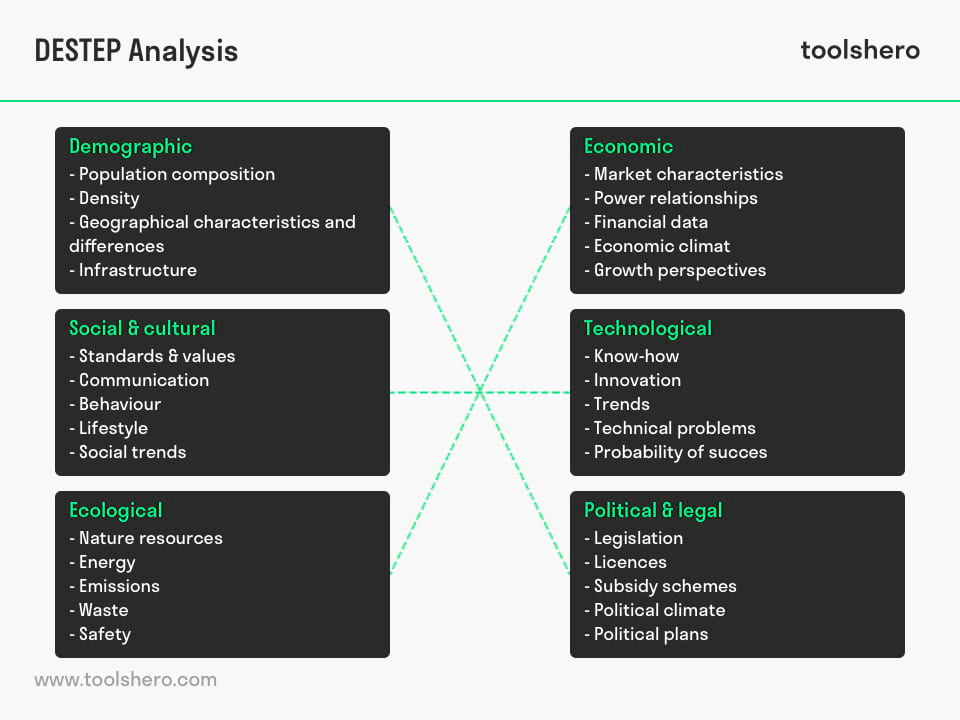DESTEP Analysis explained plus example

DESTEP Analysis: this article explains practically the DESTEP Analysis. This article contains a general meaning of the DESTEP acronym, the 6 different elements of the model,an practical DESTEP Analysis example and tips. After reading you will understand the basics and principles of this strategy and marketing tool. Enjoy reading!
What is the DESTEP Analysis? The theory
Organizations depend on their external environment. This environment can be divided into the Meso- and the Macro environment. The Meso environment is the sector or the market in which the organization is active. An organization is somewhat capable of influencing this Meso- environment.
In the Macro environment this the other way round, it influences the organization. Every organisation is faced with factors they can exert influence on and factors they cannot exert influence on at all.
This type of analysis provides more information about these Macro-economic factors. DESTEP is an acronym that stands for: Demographic, Economic, Sociocultural, Technological, Ecological and Political (elements).
The DESTEP Analysis model explained
A business and marketing model has been developed from science, indicating the factors that apply to the Macro-environment. A DESTEP Analysis clarifies how a company can best deal with such Macro-economic factors and how to adjust their strategy accordingly.

Figure 1 – The 6 Elements of DESTEP Analysis
This analysis model is the acronym for six factors:
Demographic aspects
This factor addresses the composition of the population; greater understanding of this factor could be of crucial importance for an organization.
Economic aspects
These are all factors that have to do with economic growth, inflation, purchasing power, etc.
Social (cultural) aspects
These are characteristics in the area of culture and way of life.
Technological aspects
This is about all developments and innovations an organization has to respond to in order to keep up with the times.
Ecological aspects
This includes all factors in the area of the physical surroundings and the environment.
Political-legal aspects
These are all political measures at a decision-making, provincial and municipal level.
DESTEP Analysis in practice with an example
Using this macro-economic factor analysis a company may derive strategic benefits from this. With the right advance information about the different DESTEP Analysis factors, an organization can determine, for instance, whether they should or should not open a branch in a specific environment.
Below is a DESTEP analysis example of a worldwide known coffee chain. The chosen country is the Netherlands.
Demographic aspects
Small country with high population density (16.3 million people), decreasing growth and increasing aging.
Economic aspects
Rich economy that is attractive for investors. There is economic growth (3.5% in 2006), including confidence among both consumers and producers. Expenditure per household is increasing.
Social (cultural) aspects
The Netherlands is the second country in the world with the most coffee drinkers. 70% of them drink that mainly at home.
Technological aspects
The Dutch are crazy about luxury coffee machines such as manual espresso machines.
Ecological aspects
Dutch people find coffee to be at home from other countries more important than drinking outside the door.
Political-legal aspects
The Netherlands has a fairly stable political and legal system. In addition, it also has good relations with other countries when it comes to import and export agreements.
Conclusion
For the worldwide known coffee chain, it is not interesting to open branches in the Netherlands. Despite the good import and export agreements and the rich economy, two-thirds of the Dutch prefer to drink coffee at home and enjoy it more than outside the door.
Tips that can help during the conduction of a DESTEP Analysis
The following tips are recommended for carrying out a analysis as successfully as possible:
- It is important to, in addition to the DESTEP Analysis, to continuously centre on the starting position of the organization;
- The factors of this analysis are to be considered from all angles, as a result of which both important and less important matters are highlighted.
Benefits of the DESTEP analysis
The use of this type of analysis has a number of advantages:
- It is a simple tool that can be used by anyone
- It stimulates discussions of the influence of the outside world
- It emphasizes considering the demographics of a market
- It provides a detailed but clear picture of the external factors that affect a company
It’s Your Turn
What do you think? How do you apply the DESTEP Analysis? Do you recognize the practical explanation or do you have more suggestions? What are your success factors for a good DESTEP Analysis?
Share your experience and knowledge in the comments box below.
More information
- Aguilar, F. J. (1967). Scanning the business environment. MacMillan.
- Cartwright, R. I. (2001). Mastering the business environment. Palgrave MacMillan.
- Fine, L. G. (2009). The Swot Analysis: Using Your Strength to Overcome Weaknesses, Using Opportunities to Overcome Threats. Createspace.
- Johnson, G, Scholes, K. Whittington, R. (2008). Exploring Corporate Strategy. Prentice Hall.
How to cite this article:
Van Vliet, V. (2013). DESTEP Analysis. Retrieved [insert date] from Toolshero: https://www.toolshero.com/marketing/destep-analysis/
Original publication date: 10/18/2013 | Last update: 04/29/2023
Add a link to this page on your website:
<a href=”https://www.toolshero.com/marketing/destep-analysis/”>Toolshero: DESTEP Analysis</a>













One response to “DESTEP Analysis explained plus example”
Hello, Thank you very much for your information. As a German student studying in the Netherlands, I’ll have to prepare a DESTEP-Analysis for a specific Branch. Can you give me any hints on how to include all sides of this analysis in a branch?